
International Journal of
Experimental Botany

 | Phyton- International Journal of Experimental Botany |  |
DOI: 10.32604/phyton.2021.015723
ARTICLE
Knowledge Mapping of Opuntia Milpa Alta Since 1998: A Scientometric Analysis
1Institute of Botany, Jiangsu Province and Chinese Academy of Sciences (Nanjing Botanical GardenMem. Sun Yat-Sen), Nanjing, 210014, China
2The Jiangsu Provincial Platform for Conservation and Utilization of Agricultural Germplasm, Nanjing, 210014, China
3Co-Innovation Center for Sustainable Forestry in Southern China, Nanjing Forestry University, Nanjing, 210037, China
4Center for Advanced Material Diagnostic Technology, Shenzhen Technology University, Shenzhen, 518118, China
5Key Laboratory of Novel Materials for Sensor of Zhejiang Province, College of Materials and Environmental Engineering, Hangzhou Dianzi University, Hangzhou, 310018, China
*Corresponding Authors: Yonghua Gu. Email: g_yhua@aliyun.com; Li Fu. Email: fuli@hdu.edu.cn
Received: 08 January 2021; Accepted: 04 March 2021
#These authors contributed equally to this study
Abstract: Opuntia Milpa Alta is a cactus cultivated, domesticated, hybridized and selected from the plant Opuntia ficus-indica by Mexican agricultural experts, which can be used as fruit and vegetable. Opuntia Milpa Alta leaves and fruit are superior to wild varieties and suitable for storage and transportation. In 1998, Opuntia Milpa Alta was introduced to China from Mexico by the Quality Product Development Center of the Ministry of Agriculture of China. Up to now, the Opuntia Milpa Alta has been cultivated on a certain scale in China. This study aims to identify the research progress and development trends of Opuntia Milpa Alta in China. Papers published between 1998 to 2019 from two major Chinese academic databases (CNKI and Wangfang) with a topic search related to Opuntia Milpa Alta were collected. The research progress and development trends were analyzed based on CiteSpace software of text mining and visualization. The analysis found that Opuntia Milpa Alta has gone through three obvious research phases after being introduced to China. In the first phase, the researchers paid attention to its cultivation method. Subsequently, researchers began to use extraction methods to extract some of its components, such as polysaccharides and flavonoids. Finally, these extracted ingredients began to be used in some biomedical research.
Keywords: Opuntia Milpa Alta; China; bibliometric analysis; planting technique; biomedical uses
Opuntia Milpa Alta is native to Mexico. Different from the general wild or ornamental cactus, it is an edible cactus [1–3]. It is one of the main vegetables in people’s daily life in Mexico and many European and American countries. In 1998, the Quality Product Development Center of the Ministry of Agriculture of China introduced the Opuntia Milpa Alta from Mexico, and carried out a large-scale introduction, demonstration and promotion in China. Opuntia Milpa Alta has been proven to be a new and healthy vegetable variety suitable for promotion and planting in China. It is also the only edible cactus that has passed the approvalby the Ministry of Agriculture in China. With the Chinese people’s awareness of its nutritional value and health functions, Opuntia Milpa Alta gradually entered the consumers’ tables as a new food resource and a new variety of vegetables [4–5]. Since the introduction of Opuntia Milpa Alta to China, it has been planted all over the country. Like the ordinary ornamental cacti, Opuntia Milpa Alta is a perennial, light-loving, drought-tolerant, arid-and saline-alkali-resistant. Also, it is not tolerant to neither cold nor flooding conditions. The cultivation of Opuntia Milpa Alta is relatively easy and can be grown in the open field or in the greenhouse. At present, all parts of the country, including Beijing, Hainan, Fujian, Heilongjiang, Jilin, Liaoning, Hebei, Henan, Shanxi, Shandong and other places have locations for planting, production and sale.
Opuntia Milpa Alta is a nutrient-rich, healthy vegetable with a water content of about 90%. Stems of Opuntia Milpa Alta have 85%−90% water content, 5%−12% crude protein and 2%−6% carbohydrates [6–8]. Its chemical composition is similar to other succulents [9–14]. Fruits of Opuntia Milpa Alta contain a high content of glucose and fructose (6%−8%) and a protein content of 3.2%−5.5%. They also contain a high content of fiber and vitamin C, and are rich in potassium, calcium, phosphorus, iron, magnesium and other mineral elements [15–17]. In addition, the total amount of amino acids contained in Opuntia Milpa Alta is about 6.8–7.38% [18–23]. The nutrient content of Opuntia Milpa Alta makes it not only directly edible as a vegetable, but also has a wide range of health care values. Regarding the health effects and usage methods of this edible cactus, Mexico has many records in the Pharmacopoeia [24–26].
This study aims to identify the research progress and development trends of Opuntia Milpa Alta in China. Papers from two major Chinese academic database (CNKI and Wangfang) with a topic search related to Opuntia Milpa Alta (1998–2019) were collected. The research progress and development trends were analyzed based on CiteSpace software of text mining and visualization. The concept of CNKI is National Knowledge Infrastructure (NKI), which was proposed by the World Bank in 1998. The CNKI is an informatization construction project with the goal of realizing the dissemination, sharing and value-added utilization of knowledge resources in the whole society. It was initiated by Tsinghua University and Tsinghua Tongfang and was built in June 1999. Today, it is the largest document retrieval system in China. Wanfang Database is a large-scale network database developed by the Wanfang Data Company, covering journals, papers, academic achievements, and academic conference papers. It is also an academic database of Chinese specialties that is as famous as CNKI. However, in the face of the huge amount of literature, there are certain limitations, subjectivity and one-sidedness in the analysis by reading and induction. The application of modern scientometrics and information metrology technology can carry out multivariate and diachronic dynamic analysis of massive literature data. Mapping Knowledge Domains is an important method of document analysis and visualization.
CiteSpace is a document data mining and visualization software developed by Chen’s team [27,28]. It combines cluster analysis and social network analysis. It can analyze the basic knowledge and research frontiers, research characteristics and evolution trends of a certain field through the co-citation and coupling of documents, scientific research cooperation networks and themes contributions [29–38]. The CiteSpace used in this analysis is 5.7R1. The time span is 1998–2019 (Slice Length = 1). All the original documents analyzed in this article were published in Chinese. The names of authors, journals and keywords mentioned in this article have been translated into English. This work selects all the academic articles in CNKI and Wanfang database that contain the keyword search of “Opuntia Milpa Alta”, and a total of 259 articles were obtained after screening.
3.1 Characteristics of Publication Outputs
According to the annual distribution statistics visualization map (Fig. 1), a preliminary understanding of the history of research progress for Opuntia Milpa Alta was obtained. The relevant research progress can be grouped into three phases. The first phase was from 1999 to 2003. The introduction of Opuntia Milpa Alta from Mexico to China, which attracted a large number of scientists to study this cactus, accounted for more than 45% of the total output. The second phase was from 2004 to 2010. The number of papers studying Opuntia Milpa Alta began to decline. In total, 72 papers were published accounting for about 27% of the total papers. After that, the annual research on Opuntia Milpa Alta remained at a relatively stable number, about 4 papers per year.
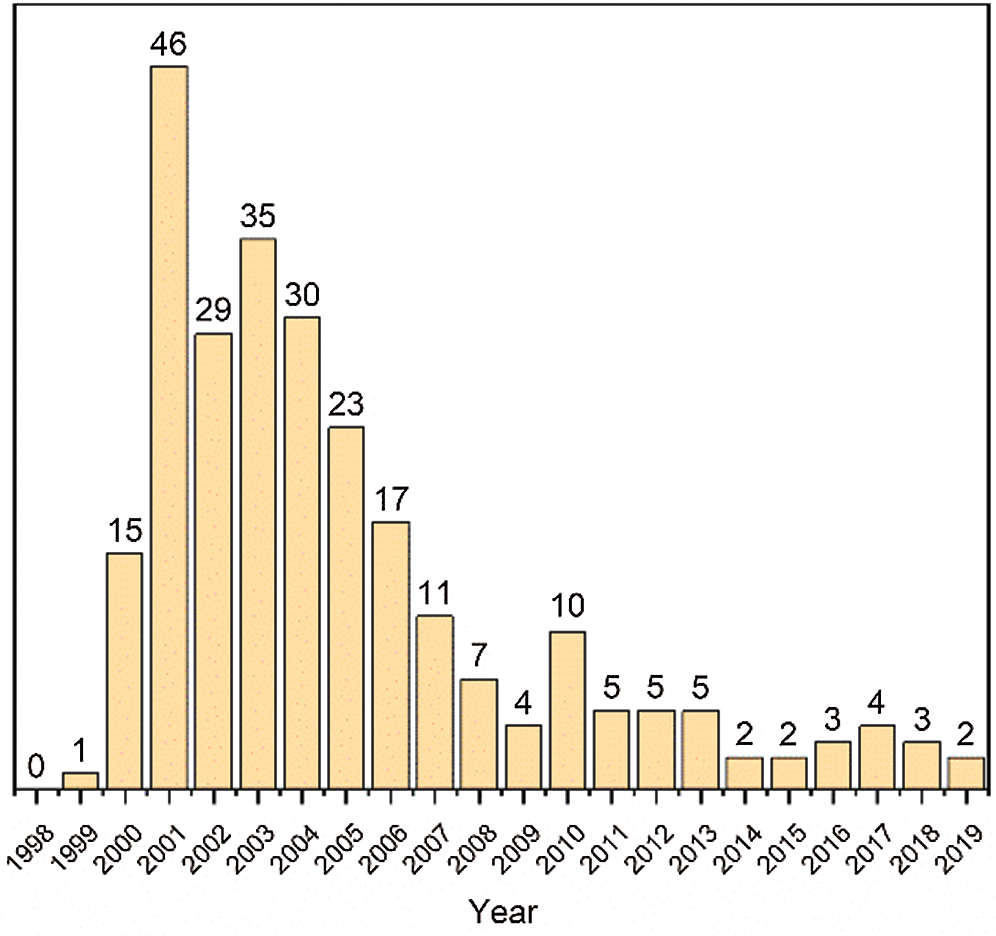
Figure 1: Annual distribution statistics visualization map of published papers related to Opuntia Milpa Alta
3.2 Author and Institution Analysis
CiteSpace author co-occurrence analysis can identify the cooperation and mutual citation relationship between core researchers in a research field. Fig. 2 shows the author’s collaboration network map (Fig. 2). As can be seen from the figure, there are two main networks and some scattered research among the people engaged in Opuntia Milpa Alta research in China. Scholars who have published more than 10 articles include Z. Wang and Y. Qiang? The most influential scholars include Q. Xiang, J. Chen, W. Cai, J. Tang, M. Lu, Z. Wu, Q. Ru, C. Li, C. Xu, K. Lin and Z. Liang. However, 92% of the authors have only published less than 3 papers related to Opuntia Milpa Alta. Tab. 1 shows all authors who published more than 3 papers related to the Opuntia Milpa Alta. It can be seen that the research of Opuntia Milpa Alta in China lacks strong leaders and close research teams. Researchers have few academic contacts and low rates of mutual citations. Therefore, research in this field has not yet formed a broad academic consensus.
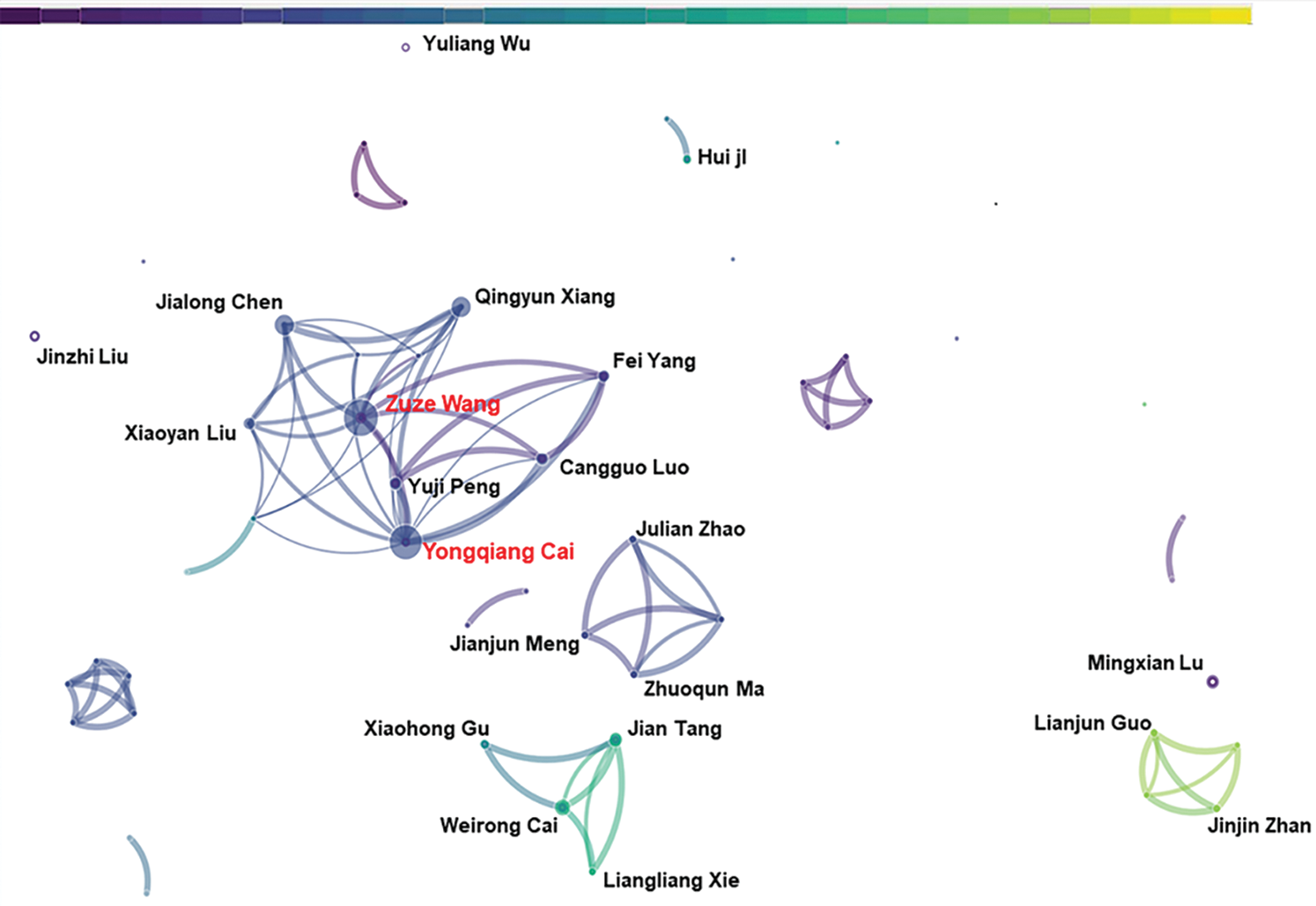
Figure 2: Author’s collaboration network map
Table 1: Author cooperation characteristics and frequency statistics in the period from 1968 to 2018
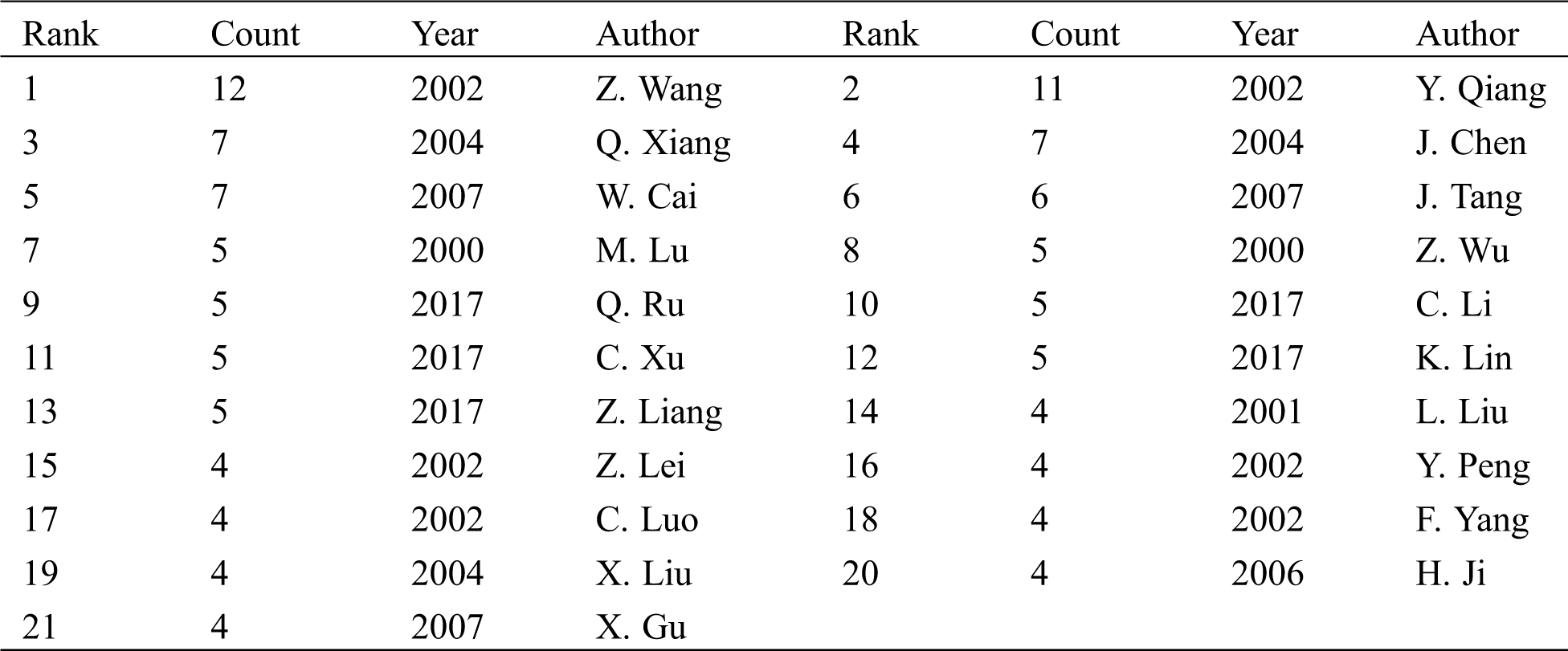
The statistics and analysis on the author’s institution were further conducted. Fig. 3 shows the time zone map of cooperative research institutions. It can be seen that the institutions that conduct research on Opuntia Milpa Alta can be divided into three stages according to time. The first stage was the first six years after Opuntia Milpa Alta was introduced to China. During this period of time, the research on Opuntia Milpa Alta was mainly carried out in agricultural institutions, such as the Shenyang Large Agricultural New Variety Breeding Center, the Guizhou Citrus Science Research Institute and the Guizhou Fruit and Vegetable Workstation. It can be considered that these works were mainly focused on the cultivation and promotion of Opuntia Milpa Alta [39]. The second stage is 2006–2012. Papers at this stage were mainly published by universities, such as Jiangnan University, Anhui Agricultural University, Anhui Institute of Engineering and Technology, Linyi Normal University and Beijing Technology and Business University. At this stage, the research on Opuntia Milpa Alta was no longer limited to simple planting and management, and more in-depth research began to be carried out in universities. The third stage started in 2014. Research on Opuntia Milpa Alta began in hospitals and biomedical companies, suggesting that researchers beganto pay attention to the medicinal and nutritional values of Opuntia Milpa Alta.
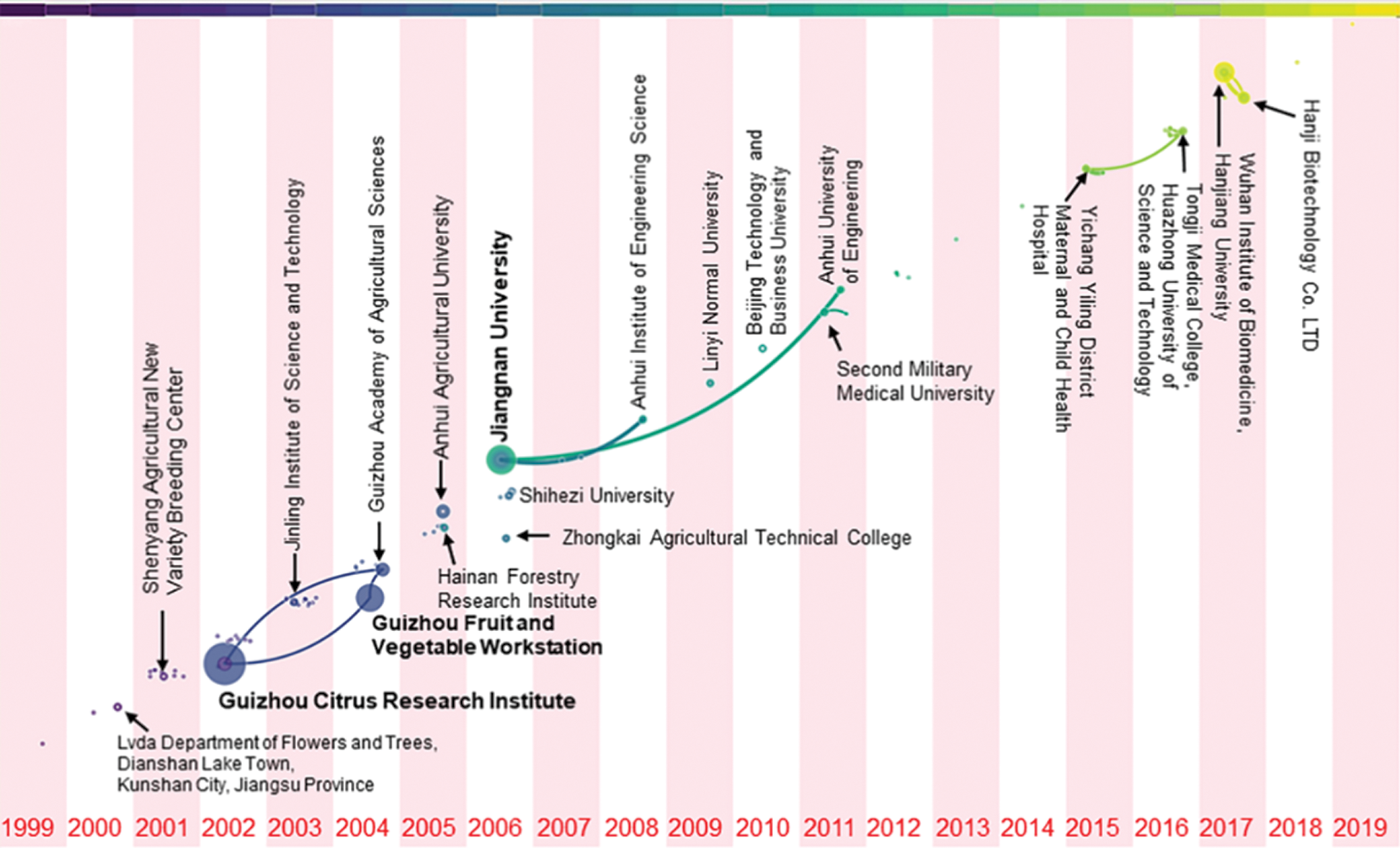
Figure 3: Time zone map of cooperative research institutions
In the CiteSpace keyword co-occurrence analysis, analyzing the changes in the number of co-occurring keywords in each year can not only judge the richness of the research field, but also judge the update speed of the content in the field and the vitality of the subject. By extracting the keywords of the Opuntia Milpa Alta research literature from 1998 to 2019, a total of 443 keywords were obtained. Fig. 4 was made according to the distribution of the number of co-occurring words in each year. It can be seen that in the first two years after Opuntia Milpa Alta was introduced in China, there were few keywords. In 2000, the keywords surged and reached its peak in 2001. The occurrence of more keywords every year shows that the research in this field is beginning to diversify. Thereafter, the emergence of keywords wasmaintained for four years (i.e., 2002–2005). During the period 2006–2010, the number of keywords each year was less than in the previous period, but it remained around 25. This phenomenon showed that the research on Opuntia Milpa Alta still maintained a certain degree of interest at this stage. Different research directions continue to produce new results. After 2010, the number of keywords began to decline, but keywords still appeared every year. This phenomenon indicates that the scope of research on Opuntia Milpa Alta beganto shrink, but in-depth research was still continued in some specific areas.
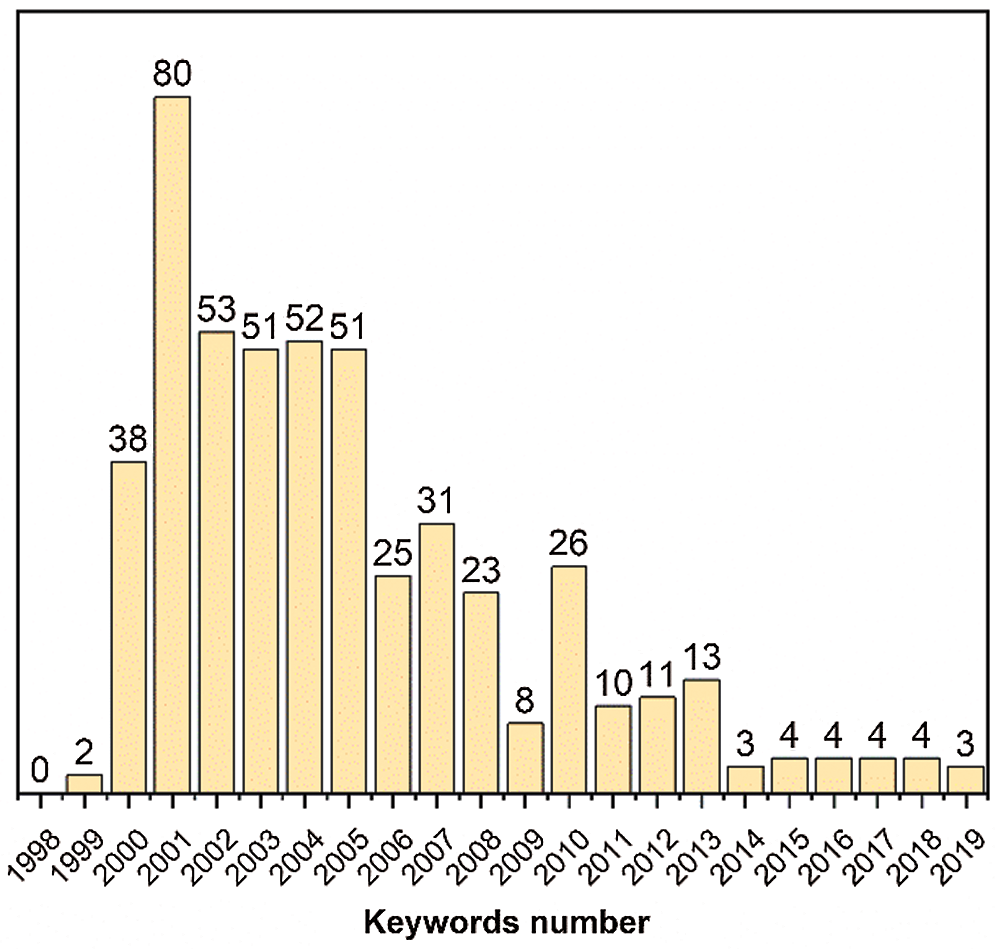
Figure 4: Annual distribution statistics visualization map of extract keywords
Tab. 2 shows the top 20 keyword frequency distribution on published papers. Most of the research on Opuntia Milpa Alta focused on planting technology, extraction and component analysis. The burst of keywords can reflect the research fields that had a greater influence over a period of time. Fig. 5 shows top 22 keywords with the strongest bursts. Among them, the top 10 keywords in the order of burst was: Opuntia Milpa Alta, Mexico, Milpa Alta, extraction, Opuntia Milpa Alta edible cactus, mice, cultivation technology, Opuntia Milpa Alta cactus, edible cactus and health vegetable. In chronological order, the burst words before 2005 were edible cactus, Opuntia Milpa Alta, health vegetable, Mexico, cultivation technology, yield and Opuntia Milpa Alta edible cactus. These keywords were all about the edible and planting techniques of Opuntia Milpa Alta. After 2005, the burst keywords becamemore diverse. Many prominent words wereabout the extract of Opuntia Milpa Alta, indicating that researchers beganto pay attention to the molecular composition of Opuntia Milpa Alta. Some keywords no directly related to Opuntia Milpa Alta appeared after 2010, such as antioxidant, anticoagulation, mice and chronic unpredictable mild stress. These keywords can be connected to medical research. At the same time, the analysis from the above institutions showed that recent studies on Opuntia Milpa Alta weremainly led by hospitals and biomedical companies. Therefore, these keywords indicated that the research on Opuntia Milpa Alta in recent years wasmainly concentrated in the field of medicine.
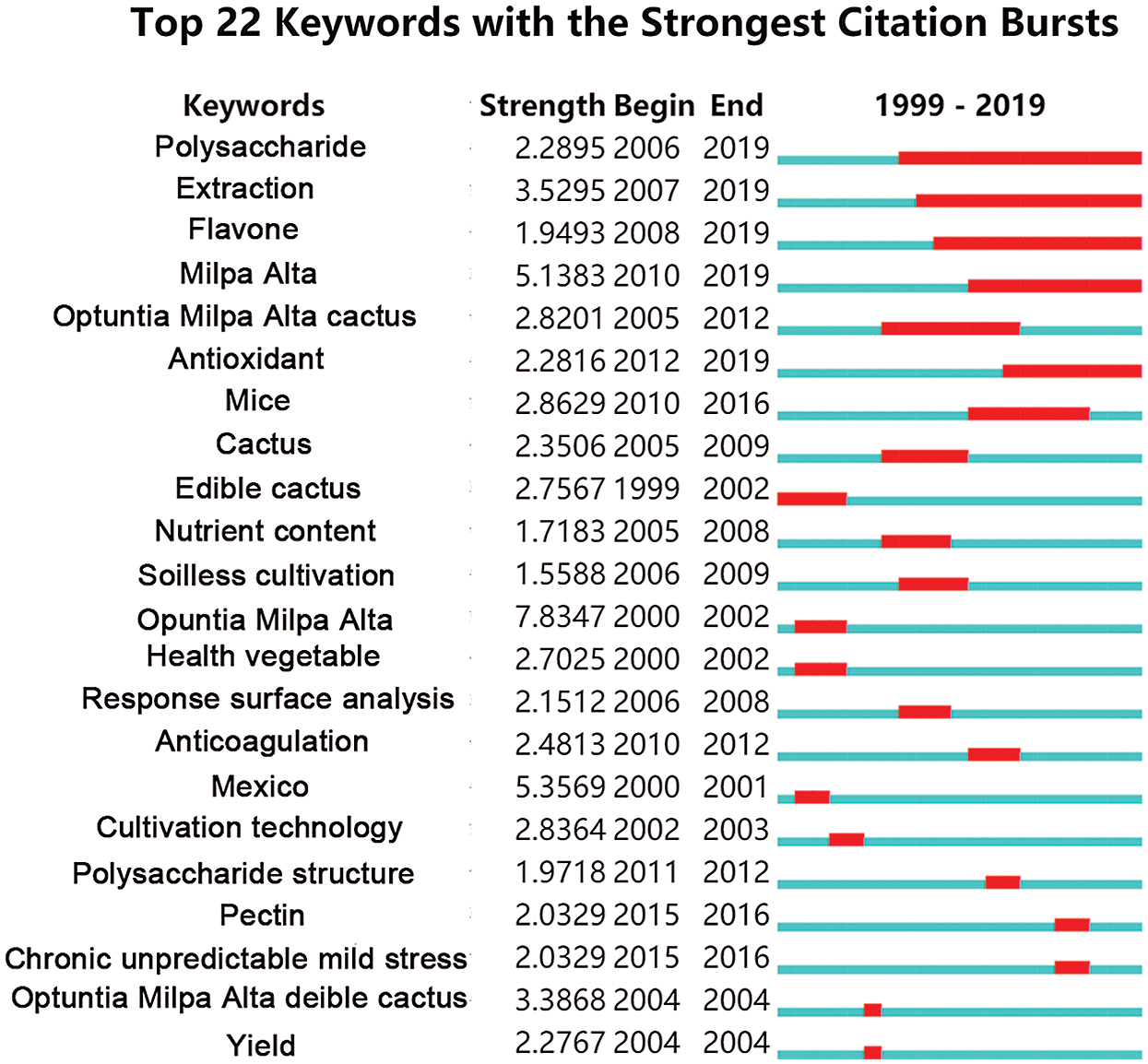
Figure 5: Top 22 keywords with the strongest bursts. In the text of the figure change deible by edible
Table 2: Top 20 keyword frequency distribution on published papers
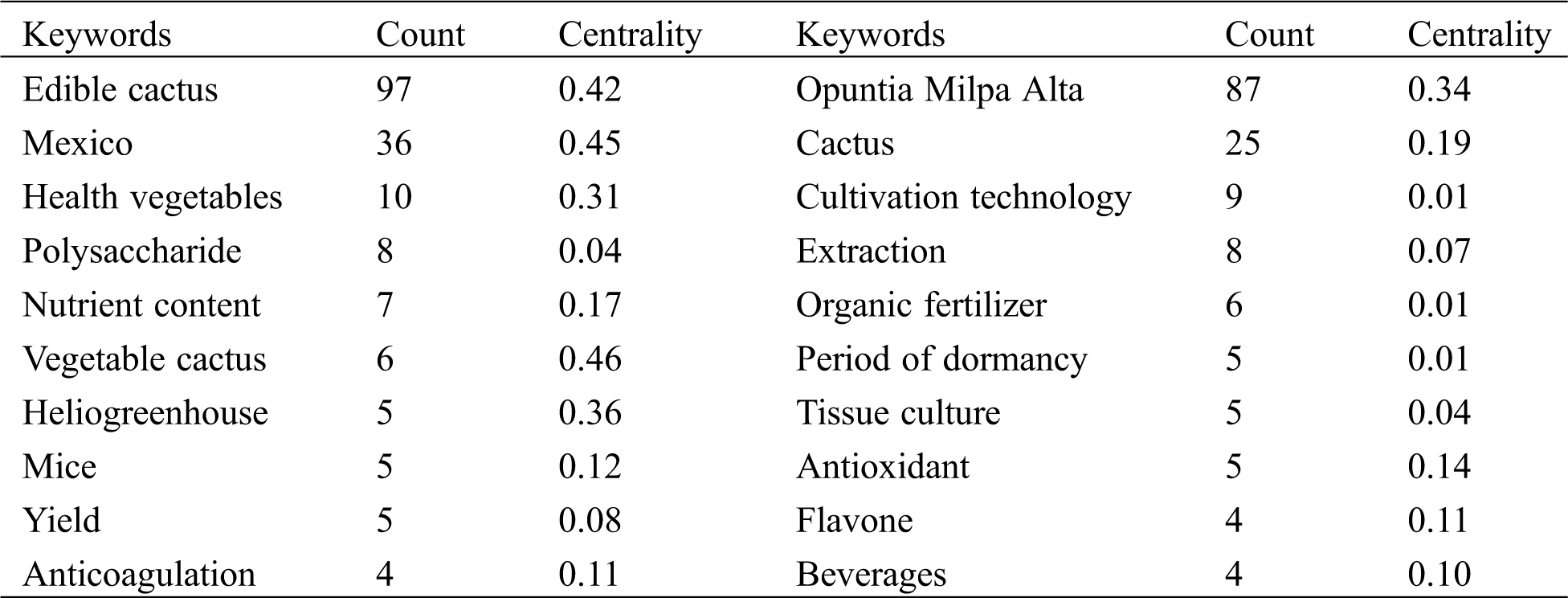
The keyword clustering map had 506 nodes and 1521 links with anetwork density of 0.0119 (Fig. 6). The Q value and the Mean Silhouette value were 0.8672 (>0.3) and 06031 (>0.4), respectively. This showed that the cluster structure of the co-occurrence map was reasonable, and the clusters had good homogeneity. From the cluster label, it wasproved once again that the research on Opuntia Milpa Alta mainly focused on planting and composition analysis. Specifically, peasant household and characteristic analysis showed arelative large cycle, suggesting that most works focused on these two areas. The keywords related to soil were closely connected with health and extraction, suggesting that soil may affect the quality and active ingredients of Opuntia Milpa Alta.
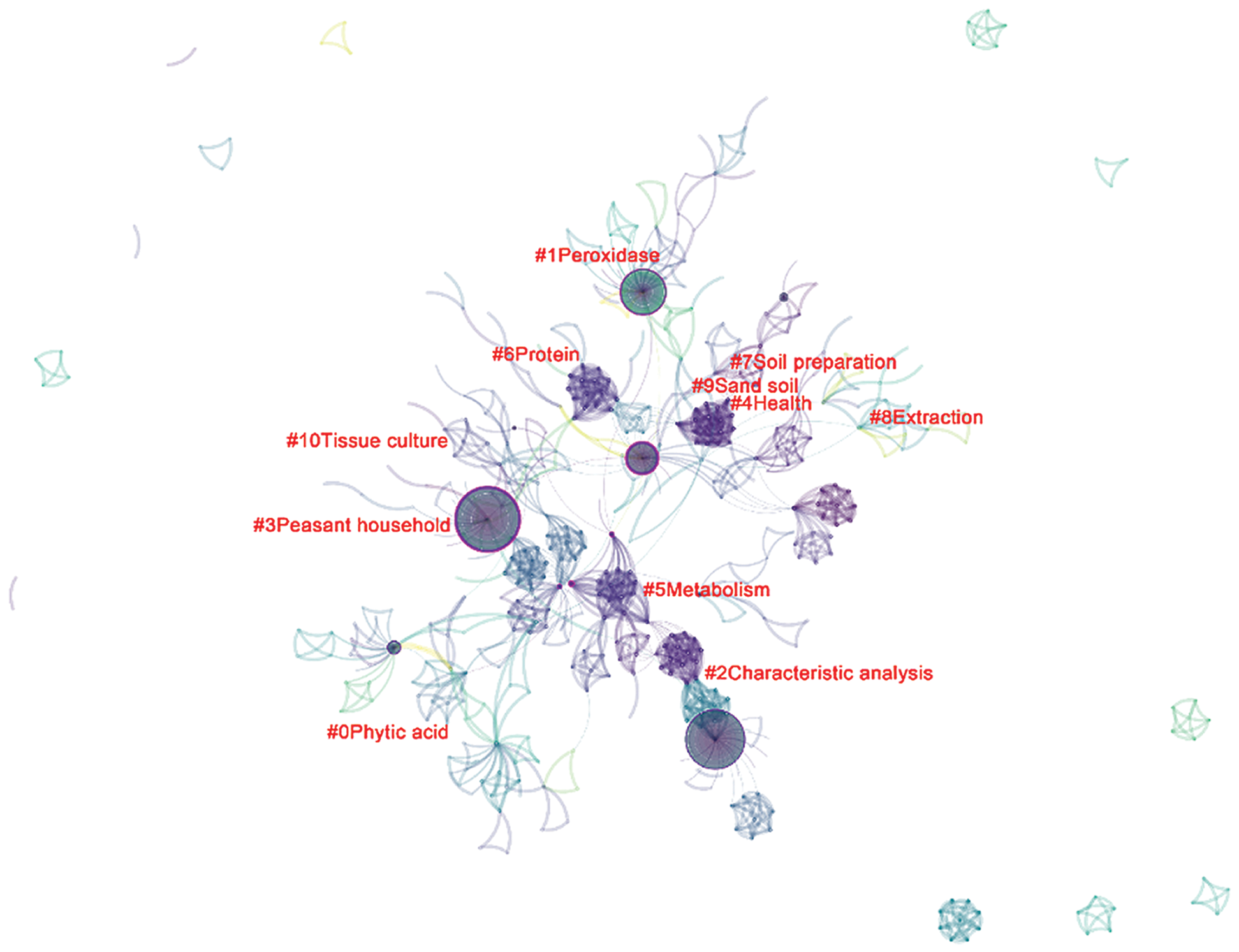
Figure 6: Keyword clustering map
3.4 Key Articles Interpretation
Based on the above bibliometric analysis, the important papers to understand the research process of Opuntia Milpa Alta after its introduction into China were further reviewed. The earliest official introduction about Opuntia Milpa Alta was by Song et al. [40] from the Vegetable Research Center of the Beijing Academy of Agriculture and Forestry Sciences. This article introduced the planting techniques, edible methods and nutritional ingredients of Opuntia Milpa Alta. A year later, Lu [41] began to emphasize that Opuntia Milpa Alta is a healthy vegetable. In the same year, Wu from the Shaanxi Provincial Association of Science and Technology published a paper on the cultivation techniques of Opuntia Milpa Alta [42]. However, the planting techniques involved in this paper may have referenced the experience inother countries [43]. Therefore, itscontent wasnot related to how to improve the cultivation in China. In papers published in 2003, researchers began to summarize the experience of planting in China. For example, Xiong [44] from Fengcheng Agricultural Development Office introduced the local planting and management methods. Qing et al. [45] introduced the cultivation technology of Opuntia Milpa Alta in the solar greenhouse. Beginning in 2004, Xiang and co-workers of the Fruit and Vegetable Workstation of Guizhou Province began to study how to increase the yield of Opuntia Milpa Alta [46,47]. They established the regression equations forpalm weight, longitudinal and transverse diameters and thickness by investigating the agronomic traits of Opuntia Milpa Alta. This model can compare the yield of different plant types. In 2007, Lei et al. [48] from Zhongkai University of Agriculture and Technology published the effect of gibberellin on the germination rate and yield of Opuntia Milpa Alta. The results showed that 40–60 mg/L gibberellin significantly increased the germination rate and shorten the germination time. This process showed that China first adopted foreign planting experience after introducing Opuntia Milpa Alta. Subsequently, according to the geographical situation of China, the researchers carried out some innovations in planting technology. Finally, they began to use pot experiments to test the effects of different single factors on yield.
Plant extraction technology is often related to the utilization of plant ingredients. Among them, the extraction of polysaccharides attracted most of the attention. This was because the polysaccharides extracted from the cactus showedobvious anti-aging, anti-inflammatory, anti-cancer and blood sugar lowering effects. Wang et al. [49] studied the effects of the extractant, liquid-to-solid ratio, and the extraction time and temperature on the extraction effect of prickly pear polysaccharides through single factor and orthogonal experiments. The anticoagulant studies of polysaccharides were subsequently launched. Cai and co-workers studied extensively the structure of the polysaccharides extracted from Opuntia Milpa Alta and verified theiranticoagulant effect [50,51].
At the same time, some researchers focused on the extraction of flavonoids [52] and pectin [53]. The extracted pectin became the forefront of Opuntia Milpa Alta research during 2009. Xiao and co-workers studied the effect of Opuntia Milpa Alta pectin extract (MCP) on the improvement of desperate symptoms in mice with chronic unpredictable temperature (CMS) and mild stress [54]. The results showed that MCP alleviated the symptoms of behavioral despair in CMS mice. A similar work was carried out by their colleagues [55]. Results from this work showed that MCP ameliorated the depression-like symptoms induced by chronic unpredictable mild stress in mice.
This work used the bibliometrics software CiteSpace to excavate and analyze all the Chinese literature published on Opuntia Milpa Alta after its introduction into China. Most research on Opuntia Milpa Alta was 3–7 years after its introduction. However, works during this period mainly focused on the investigation of its planting technology, and were mainly carried out by agriculture-related institutions. Then, with the decline in the number of published papers, the research focus on Opuntia Milpa Alta began to shift to its component analysis and extraction. Polysaccharides, flavones and pectin were the three substances that researchers were most interested in. This period of work was mainly carried out in universities. The extracted polysaccharides wereshown to have anticoagulant properties. On the other hand, the recent published papers demonstrated that the extracted pectin might improve some mental diseases. These works were mainly carried out by hospitals and biomedical companies. To date, there are still papers published every year about Opuntia Milpa Alta in China, which indicates that the plant still maintains a certain vitality in the academic field. If Opuntia Milpa Alta showed obvious value in medicine, it might lead to another wave of research.
Funding Statement: This research was supported by the National Natural Science Foundation of China (22004026), Guangdong Provincial Department of Education Young Innovative Talents Project (2019KQNCX179) and North Jiangsu Science and Technology Special Project (SZ-SQ2017006).
Conflicts of Interest: The authors declare that they have no conflicts of interest to report regarding the present study.
1. Apodaca-Pérez, J. M., Martínez-Miranda, L., Robles-Burgueño, R., Rodríguez, A. (2016). Polifenoloxidasa, fenoles totales y oscurecimiento de nopal verdura. Revista Mexicana de Ciencias Agrícolas, 7, 531–543. DOI 10.29312/remexca.v7i3.306. [Google Scholar] [CrossRef]
2. Jouini, M., Abdelhamid, A., Chaouch, M. A., le Cerf, D., Bouraoui, A. et al. (2018). Physico-chemical characterization and pharmacological activities of polysaccharides from opuntia microdasys var. rufida cladodes. International Journal of Biological Macromolecules, 107, 1330–1338. DOI 10.1016/j.ijbiomac.2017.10.003. [Google Scholar] [CrossRef]
3. Li, W., Lin, K., Zhou, M., Xiong, Q., Li, C. et al. (2020). Polysaccharides from opuntia milpa alta alleviate alloxan-induced INS−1 cells apoptosis via reducing oxidative stress and upregulating nrf2 expression. Nutrition Research, 77, 108–118. DOI 10.1016/j.nutres.2020.02.004. [Google Scholar] [CrossRef]
4. Angulo-Bejarano, P. I., Gómez-García, R., Valverde, M. E., Paredes-López, O. (2019). Nopal (Opuntia spp.) and its effects on metabolic syndrome: New insights for the use of a millenary plant. Current Pharmaceutical Design, 25, 3457–3477. DOI 10.2174/1381612825666191010171819. [Google Scholar] [CrossRef]
5. Flores, R. G. R., Martínez, O. G., Quintanilla, J. Á. V., Peña, S. R. S. (2017). Especies de hemiptera-heteroptera asociadas a opuntia spp. y nopalea spp. en el desierto chihuahuense mexicano. Revista Mexicana de Ciencias Agrícolas, 8, 1773–1784. DOI 10.29312/remexca.v8i8.701. [Google Scholar] [CrossRef]
6. Palomares-Pérez, M., Rodríguez-Leyva, E., Ortega-Arenas, L. D., Santillán-Galicia, M., Valdovinos-Ponce, G. et al. (2016). El cacarizo del nopal en opuntia ficus-indica (L.) miller, milpa alta. Ciudad de México. Agrociencia, 50, 877. DOI 10.1590/s1519-566x2010000500025. [Google Scholar] [CrossRef]
7. Zheng, Y., Zhu, J., Fu, L., Liu, Q. (2020). Phylogenetic investigation of yellow camellias based on electrochemical voltammetric fingerprints. International Journal of Electrochemical Science, 15, 9622–9630. DOI 10.20964/2020.10.54 [Google Scholar] [CrossRef]
8. Ramírez-Bustos, I. I., Saldarriaga-Noreña, H., Fernández-Herrera, E., Juárez-López, P., Alia-Tejacal, I. et al. (2019). Dissipation behavior of three pesticides in prickly pear (Opuntia ficus-indica (l.) mill.) pads in morelos, Mexico. International Journal of Environmental Research and Public Health, 16, 2922. DOI 10.3390/ijerph16162922. [Google Scholar] [CrossRef]
9. Karimi-Maleh, H., Alizadeh, M., Orooji, Y., Karimi, F., Baghayeri, M. et al. (2021). Guanine-based DNA biosensor amplified with Pt/SWCNTs nanocomposite as analytical tool for nanomolar determination of daunorubicin as an anticancer drug: A docking/experimental investigation. Industrial & Engineering Chemistry Research, 60, 816–823. DOI 10.1021/acs.iecr.0c04698. [Google Scholar] [CrossRef]
10. Karimi-Maleh, H., Ayati, A., Davoodi, R., Tanhaei, B., Karimi, F. et al. (2021). Recent advances in using of chitosan-based adsorbents for removal of pharmaceutical contaminants: A review. Journal of Cleaner Production, 291, 125880. DOI 10.1016/j.jclepro.2021.125880. [Google Scholar] [CrossRef]
11. Karimi-Maleh, H., Karimi, F., Malekmohammadi, S., Zakariae, N., Esmaeili, R. et al. (2020). An amplified voltammetric sensor based on platinum nanoparticle/polyoxometalate/two-dimensional hexagonal boron nitride nanosheets composite and ionic liquid for determination of N-hydroxysuccinimide in water samples. Journal of Molecular Liquids, 310, 113185. DOI 10.1016/j.molliq.2020.113185. [Google Scholar] [CrossRef]
12. Fu, L., Xie, K., Wang, A., Lyu, F., Ge, J. et al. (2019). High selective detection of mercury (II) ions by thioether side groups on metal-organic frameworks. Analytica Chimica Acta, 1081, 51–58. DOI 10.1016/j.aca.2019.06.055. [Google Scholar] [CrossRef]
13. Zhou, J., Zheng, Y., Zhang, J., Karimi-Maleh, H., Xu, Y. et al. (2020). Characterization of the electrochemical profiles of lycoris seeds for species identification and infrageneric relationships. Analytical Letters, 53, 2517–2528. DOI 10.1080/00032719.2020.1746327. [Google Scholar] [CrossRef]
14. Fu, L., Zheng, Y., Zhang, P., Zhang, H., Wu, M. et al. (2019). An electrochemical method for plant species determination and classification based on fingerprinting petal tissue. Bioelectrochemistry, 29, 199–205. DOI 10.1016/j.bioelechem.2019.06.001. [Google Scholar] [CrossRef]
15. Barba, F. J., Putnik, P., Bursać, K. D., Poojary, M. M., Roohinejad, S. et al. (2017). Impact of conventional and non-conventional processing on prickly pear (Opuntia spp.) and their derived products: From preservation of beverages to valorization of by-products. Trends in Food Science & Technology, 67, 260–270. DOI 10.1016/j.tifs.2017.07.012. [Google Scholar] [CrossRef]
16. Contreras-Padilla, M., Rodríguez-García, M. E., Gutiérrez-Cortez, E., Valderrama-Bravo, M. C., Rojas-Molina, J. I. et al. (2016). Physicochemical and rheological characterization of opuntia ficus mucilage at three different maturity stages of cladode. European Polymer Journal, 78, 226–234. DOI 10.1016/j.eurpolymj.2016.03.024. [Google Scholar] [CrossRef]
17. Samah, S., De Teodoro, P. C. V., Serrato, C. M. A., Valadez-Moctezuma, E. (2016). Genetic diversity, genotype discrimination, and population structure of Mexican opuntia sp., Determined by SSR Markers. Plant Molecular Biology Reporter, 34, 146–159. DOI 10.1007/s11105-015-0908-4. [Google Scholar] [CrossRef]
18. Karimi-Maleh, H., Kumar, B. G., Rajendran, S., Qin, J., Vadivel, S. et al. (2020). Tuning of metal oxides photocatalytic performance using Ag nanoparticles integration. Journal of Molecular Liquids, 314, 113588. DOI 10.1016/j.molliq.2020.113588. [Google Scholar] [CrossRef]
19. Karimi-Maleh, H., Orooji, Y., Ayati, A., Qanbari, S., Tanhaei, B. et al. (2020). Recent advances in removal techniques of Cr(VI) toxic ion from aqueous solution: A comprehensive review. Journal of Molecular Liquids, 329, 115062. DOI 10.1016/j.molliq.2020.115062. [Google Scholar] [CrossRef]
20. Karimi-Maleh, H., Karimi, F., Alizadeh, M., Sanati, A. L. (2020). Electrochemical sensors, a bright future in the fabrication of portable kits in analytical systems. The Chemical Record, 20, 682–692. DOI 10.1002/tcr.201900092. [Google Scholar] [CrossRef]
21. Fu, L., Zheng, Y., Zhang, P., Zhang, H., Zhuang, W. et al. (2018). Enhanced electrochemical voltammetric fingerprints for plant taxonomic sensing. Biosensors and Bioelectronics, 120, 102–107. DOI 10.1016/j.bios.2018.08.052. [Google Scholar] [CrossRef]
22. Fu, L., Zheng, Y., Zhang, P., Zhang, H., Xu, Y. et al. (2020). Development of an electrochemical biosensor for phylogenetic analysis of amaryllidaceae based on the enhanced electrochemical fingerprint recorded from plant tissue. Biosensors and Bioelectronics, 159, 112212. DOI 10.1016/j.bios.2020.112212. [Google Scholar] [CrossRef]
23. Zhang, M., Pan, B., Wang, Y., Du, X., Fu, L. et al. (2020). Recording the electrochemical profile of pueraria leaves for polyphyly analysis. ChemistrySelect, 5, 5035–5040. DOI 10.1002/slct.202001100. [Google Scholar] [CrossRef]
24. Gómez-Otamendi, E., Ortiz-Arteaga, Y., Ávila-Gómez, E. S., Pérez-Toledo, G., Valenzuela, J. et al. (2018). Diversidad de hormigas epigeas en cultivos de nopal tunero (Opuntia albicarpa) y matorrales de opuntia spp. del estado de hidalgo, méxico. Revista Mexicana de Biodiversidad, 89, 454–465. DOI 10.22201/ib.20078706e.2018.2.2293. [Google Scholar] [CrossRef]
25. Santiago-Lorenzo, M., López-Jiménez, A., Saucedo-Veloz, C., Cortés-Flores, J. I., Jaén-Contreras, D. et al. (2016). Composición nutrimental del nopal verdura producido con fertilización mineral y orgánica. Revista Fitotecnia Mexicana, 39, 403–407. DOI 10.35196/rfm.2016.4.403-407. [Google Scholar] [CrossRef]
26. Villanueva, E. (2016). Biología de chilocorus cacti linnaeus (Coleoptera: Coccinellidae) en condiciones de laboratorio. Dugesiana, 23, 45–50. [Google Scholar]
27. Chen, C. (2006). Citespace II: Detecting and visualizing emerging trends and transient patterns in scientific literature. Journal of the American Society for Information Science and Technology, 57, 359–377. DOI 10.1002/(ISSN)1532-2890. [Google Scholar] [CrossRef]
28. Chen, C., Hu, Z., Liu, S., Tseng, H. (2012). Emerging trends in regenerative medicine: A scientometric analysis in citeSpace. Expert Opinion on Biological Therapy, 12, 593–608. DOI 10.1517/14712598.2012.674507. [Google Scholar] [CrossRef]
29. Chen, X., Liu, Y. (2020). Visualization analysis of high-speed railway research based on citeSpace. Transport Policy, 85, 1–17. DOI 10.1016/j.tranpol.2019.10.004. [Google Scholar] [CrossRef]
30. Cui, Y., Mou, J., Liu, Y. (2018). Knowledge mapping of social commerce research: A visual analysis using citeSpace. Electronic Commerce Research, 18, 837–68. DOI 10.1007/s10660-018-9288-9. [Google Scholar] [CrossRef]
31. Fang, Y., Yin, J., Wu, B. (2018). Climate change and tourism: A scientometric analysis using citeSpace. Journal of Sustainable Tourism, 26, 108–126. DOI 10.1080/09669582.2017.1329310. [Google Scholar] [CrossRef]
32. Li, X., Ma, E., Qu, H. (2017). Knowledge mapping of hospitality research−A visual analysis using citeSpace. International Journal of Hospitality Management, 60, 77–93. DOI 10.1016/j.ijhm.2016.10.006. [Google Scholar] [CrossRef]
33. Li, X., Li, H. (2018). A visual analysis of research on information security risk by using citeSpace. IEEE Access, 6, 63243–63257. DOI 10.1109/Access.6287639. [Google Scholar] [CrossRef]
34. Tho, S. W., Yeung, Y. Y., Wei, R., Chan, K. W., So, W. W. (2017). A systematic review of remote laboratory work in science education with the support of visualizing its structure through the histCite and citeSpace software. International Journal of Science and Mathematics Education, 15, 1217–1236. DOI 10.1007/s10763-016-9740-z. [Google Scholar] [CrossRef]
35. Wang, W., Lu, C. (2020). Visualization analysis of big data research based on citespace. Soft Computing, 24, 8173–8186. DOI 10.1007/s00500-019-04384-7. [Google Scholar] [CrossRef]
36. Wei, F., Grubesic, T. H., Bishop, B. W. (2015). Exploring the GIS knowledge domain using citeSpace. The Professional Geographer, 67, 374–84. DOI 10.1080/00330124.2014.983588. [Google Scholar] [CrossRef]
37. Xiao, F., Li, C., Sun, J., Zhang, L. (2017). Knowledge domain and emerging trends in organic photovoltaic technology: A scientometric review based on citeSpace analysis. Frontiers in Chemistry, 5, 67. DOI 10.3389/fchem.2017.00067. [Google Scholar] [CrossRef]
38. Yao, L., Hui, L., Yang, Z., Chen, X., Xiao, A. (2020). Freshwater microplastics pollution: Detecting and visualizing emerging trends based on citespace II. Chemosphere, 245, 125627. DOI 10.1016/j.chemosphere.2019.125627. [Google Scholar] [CrossRef]
39. Fu, L., Wu, M., Zheng, Y., Zhang, P., Ye, C. et al. (2019). Lycoris species identification and infrageneric relationship investigation via graphene enhanced electrochemical fingerprinting of pollen. Sensors and Actuators B: Chemical, 298, 126836. DOI 10.1016/j.snb.2019.126836. [Google Scholar] [CrossRef]
40. Song, S., Xue, Y., Wu, X. (1999). A new vegetable resource——Opuntia milpa alta edible cactus. Vegetables, 12, 3–5. [Google Scholar]
41. Lu, M. (2000). A new type of health vegetable-‘Opuntia milpa alta’ edible cactus. Jilin Vegetables, 3, 32–33. [Google Scholar]
42. Wu, Z. (2000). Mexico ‘Opuntia milpa alta’ edible cactus cultivation points. Technology Wealth Guide, 12, 13–14. [Google Scholar]
43. Fu, L., Wang, A., Xie, K., Zhu, J., Chen, F. et al. (2020). Electrochemical detection of silver ions by using sulfur quantum dots modified gold electrode. Sensors and Actuators B: Chemical, 304, 127390. DOI 10.1016/j.snb.2019.127390. [Google Scholar] [CrossRef]
44. Xiong, Y. (2003). Development, utilization and cultivation techniques of edible cactus mibanta. Jiangxi Agricultural Science and Technology, 6, 23–24. [Google Scholar]
45. Qing, Y., Gao, J. (2003). Study on cultivation technology of edible cactus in solar greenhouse. Journal of Xinjiang Agricultural University, 3, 67–69. [Google Scholar]
46. Xiang, Q., Cai, Y., Chen, J., Wang, Z., Liu, X. (2004). Study on the cultivation of high-yielding plant type of edible cactus of mibonta. Guizhou Agricultural Science, 6, 57–58. [Google Scholar]
47. Xiang, Q., Cai, Y., Chen, J., Wang, Z., Liu, X., Shao, Y. (2004). Study on adaptability of mibonta to eating cactus. Guizhou Agricultural Science, 6, 63–64. [Google Scholar]
48. Lei, Z., Fei, Y., Guan, W. (2007). Effect of gibberellin (GA3) on germination rate and yield of edible cactus. Acta Agriculturae Jiangxim, 17, 60–62. [Google Scholar]
49. Wang, S., Huang, J., Xu, B. (2008). Study on extraction conditions of polysaccharides from cactus mibanta. Journal of Xhejiang Wanli University, 21, 81–84. [Google Scholar]
50. Cai, W., Xie, L., Tang, J. (2012). Structure analysis and anticoagulant activity of cactus polysaccharide. Anhui Agricultural Science, 4, 2310–2314. [Google Scholar]
51. Cai, W., Gu, X., Tang, J. (2010). Study on extraction and purification of polysaccharide from cactus and its anticoagulant activity. Food Science, 6, 131–136. [Google Scholar]
52. Cai, W., Tang, J. (2008). Optimization of extraction technology of flavonoids from cactus skin. Journal of Agricultural Engineering, 6, 299–303. [Google Scholar]
53. Sheng, X., Yan, X. (2009). Study on the technology of extracting pectin from cactus mibonta by salting out. Tropical Forest, 37, 19–21. [Google Scholar]
54. Xiao, T., Huang, C., Yang, X., Zhan, J., Guo, L. (2015). Effect of mibonta cactus pectin on the improvement of despair symptoms in mice with chronic unpredictable mild stress. Journal of Modern Integrated Chinese and Western Medicine, 24, 2630–2631. [Google Scholar]
55. Zhang, Y., Li, Z., Luo, P., Zhan, J., Guo, L. (2016). Effect of mibonta cactus pectin on the improvement of depression-like symptoms caused by chronic unpredictable mild stress in mice. Nerve Injury and Functional Reconstruction, 11, 385–387. [Google Scholar]
 | This work is licensed under a Creative Commons Attribution 4.0 International License, which permits unrestricted use, distribution, and reproduction in any medium, provided the original work is properly cited. |